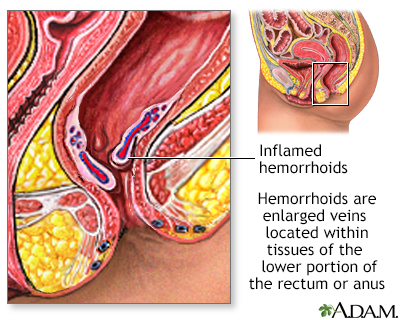Hemorrhoids
Rectal lump; Piles; Lump in the rectum; Rectal bleeding - hemorrhoids; Blood in the stool - hemorrhoids
Hemorrhoids are swollen veins in the anus or lower part of the rectum.
Images

Presentation

I Would Like to Learn About:
Causes
Hemorrhoids are very common. They result from increased pressure on the anus. This can occur during pregnancy or childbirth, and due to constipation. The pressure causes the normal anal veins and tissue to swell. This tissue can bleed, often during bowel movements.
Hemorrhoids may be caused by:
- Straining during bowel movements
- Constipation
- Sitting for long periods of time, especially on the toilet
- Certain diseases, such as cirrhosis
Hemorrhoids may be inside or outside the body.
- Internal hemorrhoids occur just inside the anus, at the beginning of the rectum. When they are large, they may fall outside (prolapse). The most common problem with internal hemorrhoids is bleeding during bowel movements.
- External hemorrhoids occur outside the anus. They can result in difficulty cleaning the area after a bowel movement. If a blood clot forms in an external hemorrhoid, it can be very painful (thrombosed external hemorrhoid).
Symptoms
Hemorrhoids are most often not painful, but if a blood clot forms, they can be very painful.
Common symptoms include:
- Painless bright red blood from the rectum
- Anal itching
- Anal ache or pain, especially while sitting
- Pain during bowel movements
- One or more hard or tender lumps near the anus
Exams and Tests
Most of the time, a health care provider can diagnose hemorrhoids by simply looking at the rectal area. External hemorrhoids can often be detected this way.
Tests that may help diagnose the problem include:
- Rectal exam
- Sigmoidoscopy
- Anoscopy
Treatment
Treatments for hemorrhoids include:
- Over-the-counter corticosteroid (for example, hydrocortisone) creams to help reduce pain and swelling
- Hemorrhoid creams with lidocaine or other anesthetic to help reduce pain
- Stool softeners to help reduce straining and constipation
Things you can do to reduce itching include:
- Apply witch hazel to the area with a cotton swab.
- Wear cotton underwear.
- Avoid toilet tissue with perfumes or colors. Use baby wipes instead.
- Try not to scratch the area.
Sitz baths can help you to feel better. Sit in warm water for 10 to 15 minutes.
If your hemorrhoids do not get better with home treatments, you may need some type of office treatment to shrink the hemorrhoids.
If office treatment is not enough, some type of surgery may be necessary, such as removal of the hemorrhoids (hemorrhoidectomy). These procedures are generally used for people with severe bleeding or prolapse who have not responded to other therapy.
Possible Complications
The blood in the hemorrhoid may form clots. This can cause tissue around it to die. Surgery is sometimes needed to remove hemorrhoids with clots.
Rarely, severe bleeding may also occur. Iron deficiency anemia can result from long-term blood loss.
When to Contact a Medical Professional
Contact your provider if:
- Hemorrhoid symptoms do not improve with home treatment.
- You have rectal bleeding. Your provider may want to check for other, more serious causes of the bleeding.
Get medical help right away if:
- You lose a lot of blood
- You are bleeding and feel dizzy, lightheaded, or faint
Prevention
Constipation, straining during bowel movements, and sitting on the toilet too long raise your risk for hemorrhoids. To prevent constipation and hemorrhoids, you should:
- Drink plenty of fluids.
- Eat a high-fiber diet of fruits, vegetables, and whole grains.
- Consider using fiber supplements.
- Use stool softeners to prevent straining.
Related Information
CirrhosisIron deficiency anemia
References
Bass LM, Wershil BK. Anatomy, histology, embryology, and developmental anomalies of the small and large intestine. In: Feldman M, Friedman LS, Brandt LJ, eds. Sleisenger and Fordtran's Gastrointestinal and Liver Disease: Pathophysiology/Diagnosis/Management. 11th ed. Philadelphia, PA: Elsevier; 2021:chap 98.
Cameron J. Anorectal. In: Cameron J, ed. Current Surgical Therapy. 14th ed. Philadelphia, PA: Elsevier; 2023:chap 5.
Zainea GG, Pfenninger JL. Office treatment of hemorrhoids. In: Fowler GC, ed. Pfenninger and Fowler's Procedures for Primary Care. 4th ed. Philadelphia, PA: Elsevier; 2020:chap 87.
BACK TO TOPReview Date: 9/9/2023
Reviewed By: Debra G. Wechter, MD, FACS, General Surgery Practice Specializing in Breast Cancer, Virginia Mason Medical Center, Seattle, WA. Also reviewed by David C. Dugdale, MD, Medical Director, Brenda Conaway, Editorial Director, and the A.D.A.M. Editorial team.

Health Content Provider
06/01/2025
|
A.D.A.M., Inc. is accredited by URAC, for Health Content Provider (www.urac.org). URAC's accreditation program is an independent audit to verify that A.D.A.M. follows rigorous standards of quality and accountability. A.D.A.M. is among the first to achieve this important distinction for online health information and services. Learn more about A.D.A.M.'s editorial policy, editorial process and privacy policy. A.D.A.M. is also a founding member of Hi-Ethics. This site complied with the HONcode standard for trustworthy health information from 1995 to 2022, after which HON (Health On the Net, a not-for-profit organization that promoted transparent and reliable health information online) was discontinued. |
The information provided herein should not be used during any medical emergency or for the diagnosis or treatment of any medical condition. A licensed medical professional should be consulted for diagnosis and treatment of any and all medical conditions. Links to other sites are provided for information only -- they do not constitute endorsements of those other sites. © 1997- 2025 A.D.A.M., a business unit of Ebix, Inc. Any duplication or distribution of the information contained herein is strictly prohibited.
